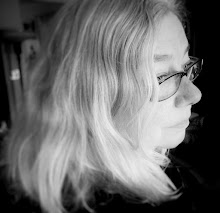Yesterday, being Saturday, was Sit & Stitch day and I had no idea what to bring along to work on. The Elbistan mittens require too much concentration, as do the little Selbuvotter (#2 of the teal-y pair), the Wool Peddler's shawl isn't a take-along project anymore and there was nothing else I really felt like working on. I finally settled on the Setesdal baby sweater that I started last year and got stalled on.
Over the course of the last few weeks, I've been doing a little research on steeking so that I could understand (and visualize) what the instructions were telling me to do, and why. I now know that there's a difference between Fair Isle steeking and Norwegian steeking, and now that I know how the Norwegian steeking is done, the little sweater is moving ahead.

So, what is the difference? Well, with Fair Isle steeking, four or five stitches are added where the arm holes will be. Later, when ready for steeking, the stitches are reinforced, cut, stitches are picked up and the sleeves are knit down (that's the basic explanation).

If you'd like to know more about the differences between the two methods of steeking, Eunny Jang has a great tutorial on her blog. She explains the differences very well and goes into the pros and cons of both methods. I will warn you, though, she's not a fan of Norwegian steeking, especially of the fact that you have to use a sewing machine to anchor the steek. She doesn't consider the sewing machine a traditional method. If you do read her explanation, I would recommend reading the comments as well; there's some good information and rebuttal from Norwegian knitters.
With Norwegian steeking, there are no extra stitches involved. In the case of this little sweater, there is one purl stitch on either side, basically a seam stitch. Later, I'll be machine stitching on either side of that single stitch, then cutting through that same stitch. The sleeves are knit separately, from the cuff up, with a "facing" worked at the top of the sleeve; the sleeve is then stitched in place and the facing is stitched down, covering the cut edge, making everything neat and tidy.

If you'd like to know more about the differences between the two methods of steeking, Eunny Jang has a great tutorial on her blog. She explains the differences very well and goes into the pros and cons of both methods. I will warn you, though, she's not a fan of Norwegian steeking, especially of the fact that you have to use a sewing machine to anchor the steek. She doesn't consider the sewing machine a traditional method. If you do read her explanation, I would recommend reading the comments as well; there's some good information and rebuttal from Norwegian knitters.
It will be a while before I get to that point, but when I do, you can be sure I'll be taking pictures and documenting the process.... with a celebratory glass of wine near at hand! Or perhaps a glass of wine for courage???









I highly recommend the crochet method of reinforcing for norweigan steeks. No stitches caught in the feed dogs. And I doubt that the early Norweigan sweaters were machine stitched for reinforcement. Let me know if you want some pointers when you get that far.
ReplyDelete